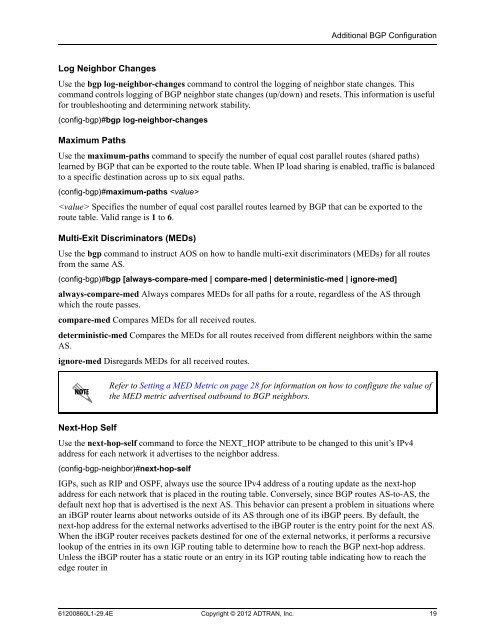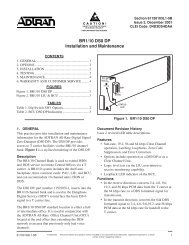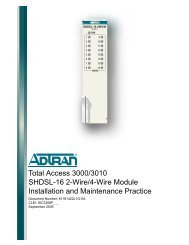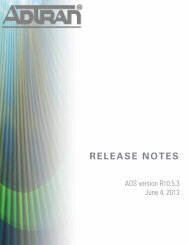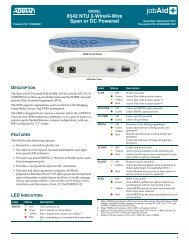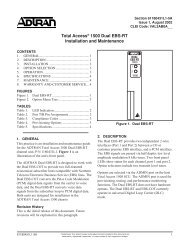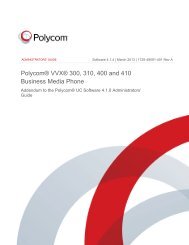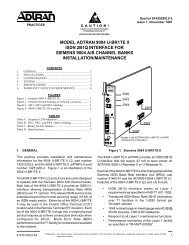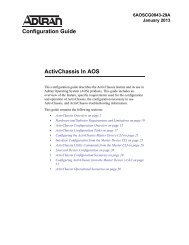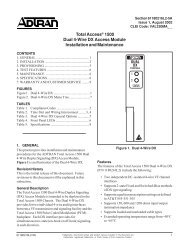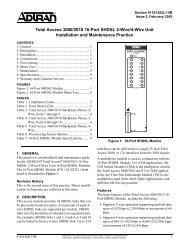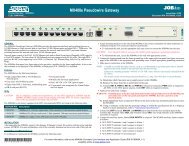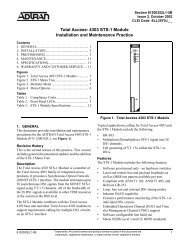View - ADTRAN Support Community
View - ADTRAN Support Community
View - ADTRAN Support Community
You also want an ePaper? Increase the reach of your titles
YUMPU automatically turns print PDFs into web optimized ePapers that Google loves.
Additional BGP Configuration<br />
Log Neighbor Changes<br />
Use the bgp log-neighbor-changes command to control the logging of neighbor state changes. This<br />
command controls logging of BGP neighbor state changes (up/down) and resets. This information is useful<br />
for troubleshooting and determining network stability.<br />
(config-bgp)#bgp log-neighbor-changes<br />
Maximum Paths<br />
Use the maximum-paths command to specify the number of equal cost parallel routes (shared paths)<br />
learned by BGP that can be exported to the route table. When IP load sharing is enabled, traffic is balanced<br />
to a specific destination across up to six equal paths.<br />
(config-bgp)#maximum-paths <br />
Specifies the number of equal cost parallel routes learned by BGP that can be exported to the<br />
route table. Valid range is 1 to 6.<br />
Multi-Exit Discriminators (MEDs)<br />
Use the bgp command to instruct AOS on how to handle multi-exit discriminators (MEDs) for all routes<br />
from the same AS.<br />
(config-bgp)#bgp [always-compare-med | compare-med | deterministic-med | ignore-med]<br />
always-compare-med Always compares MEDs for all paths for a route, regardless of the AS through<br />
which the route passes.<br />
compare-med Compares MEDs for all received routes.<br />
deterministic-med Compares the MEDs for all routes received from different neighbors within the same<br />
AS.<br />
ignore-med Disregards MEDs for all received routes.<br />
Refer to Setting a MED Metric on page 28 for information on how to configure the value of<br />
the MED metric advertised outbound to BGP neighbors.<br />
Next-Hop Self<br />
Use the next-hop-self command to force the NEXT_HOP attribute to be changed to this unit’s IPv4<br />
address for each network it advertises to the neighbor address.<br />
(config-bgp-neighbor)#next-hop-self<br />
IGPs, such as RIP and OSPF, always use the source IPv4 address of a routing update as the next-hop<br />
address for each network that is placed in the routing table. Conversely, since BGP routes AS-to-AS, the<br />
default next hop that is advertised is the next AS. This behavior can present a problem in situations where<br />
an iBGP router learns about networks outside of its AS through one of its iBGP peers. By default, the<br />
next-hop address for the external networks advertised to the iBGP router is the entry point for the next AS.<br />
When the iBGP router receives packets destined for one of the external networks, it performs a recursive<br />
lookup of the entries in its own IGP routing table to determine how to reach the BGP next-hop address.<br />
Unless the iBGP router has a static route or an entry in its IGP routing table indicating how to reach the<br />
edge router in<br />
61200860L1-29.4E Copyright © 2012 <strong>ADTRAN</strong>, Inc. 19


